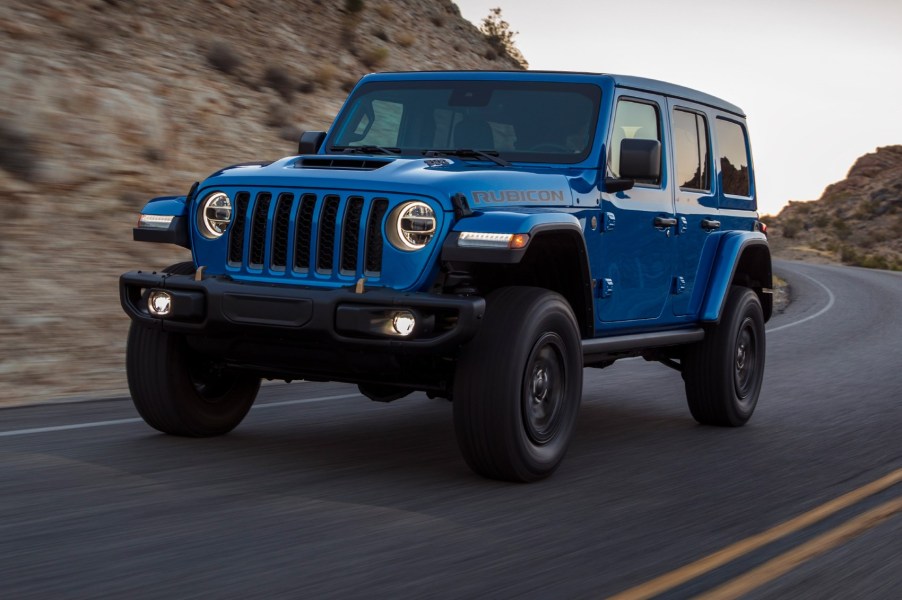
The Most Frustrating Thing About Owning a Jeep Wrangler
As offroaders go, the Jeep Wrangler has many of its rivals beat in the looks department. Outside, it sports the iconic seven-slot grille that harkens back to the CJ and the square fenders that echo the original Willys MB. The interior shares much of the exterior’s clean lines and rugged functionality.
Its satisfying offroad capabilities allow it to crawl and climb just about anywhere. But the Jeep Wrangler does have one hugely frustrating drawback, along with a couple of minor ones. Check out the potential downsides of Wrangler ownership.
The biggest JeepWrangler problem

For the past seven months, Seabaugh has been reporting on his driving experience with a 2019 Jeep Wrangler Unlimited Rubicon. He has used the Wrangler as a daily driver, a beach offroader, and a weekend explorer during this time.
Their Wrangler is equipped with an eTorque 2.0-liter mild-hybrid turbocharged inline four-cylinder engine with 270 hp and 295 lb-ft of torque. It’s mated with an eight-speed automatic transmission.
Normally, a mild-hybrid engine would save gas by shutting off the engine when it’s cruising, braking, or stopping. So, theoretically, the Wrangler should get a good fuel economy with this configuration.
But in the real world, this isn’t the case and is the Wrangler’s most glaring problem. At 22/24/22 MPG city/highway/combined, the EPA numbers seem decent enough.
They performed their own gas mileage testing for this vehicle at the half-year mark of testing. The results were 21.4/26.0/23.2 MPG, which is somewhat better than the EPA’s numbers.
It’s reasonable to expect that driving the Jeep Wrangler under real-world conditions would match critics or the EPA’s results.
Instead, its fuel efficiency was surprisingly unreliable and subject to random driving conditions. For example, the Wrangler measured between 17 and 20 MPG in Los Angeles traffic at speeds under 55 MPH.
Gas mileage for highway driving was even more unpredictable. At 70 MPH in windy conditions on the freeway, the Wrangler returned only 14 MPG. When the team drove the Jeep over the mountains and through the desert in cool, calm weather, it got as much as 23 MPG.
Why is the Jeep Wrangler’s gas mileage so inconsistent?
The Jeep Wrangler’s erratic fuel economy is baffling, and it complicated the team’s route planning for trips. Yet Seabaugh does hint at one potential reason for it: the Jeep’s distinctly boxy body. Its angular shape makes the Wrangler more susceptible to wind resistance.
Reduced airflow around the Jeep’s body means that it burns more gas at the same speed than a more aerodynamic vehicle would.
At 4,439 pounds, the Rubicon Wrangler’s weight could also have some bearing on its gas mileage. Although it doesn’t have the heft of a Land Rover Defender or a Toyota Land Cruiser, the Jeep Wrangler’s sturdy construction might make it burn fuel less efficiently.
Some of its best offroad-worthy features may add weight, such as its gigantic 33-inch all-terrain tires and Dana 44 front axle.
Another consideration is that this Wrangler model has an automatic transmission. Automatics generally get slightly worse mileage than manual transmissions. It’s possible that this Jeep is getting at least two MPG less than another Wrangler model that has a manual transmission.
Minor Wrangler drawbacks

Besides the Jeep Wrangler’s puzzlingly varying fuel mileage, Seabaugh pointed out two other lesser problems.
First, he dislikes the Jeep’s on-center steering feel. The big tires, lagging steering rack, and a solid front axle all contribute to the feeling that the Wrangler is meandering slightly back and forth in its lane despite the steering being on the center.
Seabaugh believes that the slight but continuous steering adjustments a driver needs to keep the Jeep Wrangler in its lane add to driver fatigue on long trips. Although Jeep recently recalled the Wrangler to install a steering damper to remedy the 2018 model’s “death wobble,” the problem with on-center steering never went away.
The other complaint is about the design of the rear hatch. In order to access the cargo area, an owner must pull the lower door open and swing it out toward the passenger side.
Then, he or she has to lift up the rear glass of the hard-top. If the Wrangler is equipped with the optional soft-top, it’s even more tricky because it must be removed before performing these steps.
This design enables Jeep to attach a full-size spare tire to the Wrangler’s door and also allows both hard-top and soft-top options. And it’s a design that has been used going back to the CJ7 in the mid-1970s. But Seabaugh notes that it makes loading bulkier cargo such as suitcases and groceries more awkward.
As Seabaugh notes, though, there isn’t room to mount the tire underneath on the Wrangler as there is on the Jeep Gladiator. A rear hatch isn’t feasible as long as a soft top is an option.
Plus, a design such as a swing-down tailgate wouldn’t work either because it would mean that the spare tire would have to be moved. Seabaugh admits that Jeep is working with the best possible design for cargo access, even if it’s somewhat inconvenient.
It’s helpful for buyers to know about the Jeep Wrangler’s fluctuating fuel economy and other, smaller issues. But they will have to weigh these disadvantages against this SUV’s impressive off-road capabilities when decision-making time comes around.





